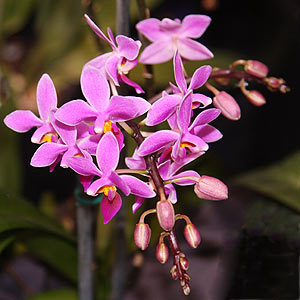A species orchid, Phalaenopsis equestris deserves a little more recognition than it gets. Originally found in Taiwan parts of China and the Phillipines this is an epiphytic plant that is easy to grow.

It is not the ease of growing this species that makes it valuable but some of the genetic traits that are important in hybridisation.
This is a smaller flowering species that is used to ‘miniaturise’ hybrids. It is also long flowering and prolific.
So what we gain from Phalaenopsis equestris hybrids are masses of smaller but long lasting flowers. It is also a species that’ll flower repeatedly 2-4 times a year in ideal conditions.
Sometimes referred to as the ‘Moth Orchid’ as the flower is said to resemble a moth.
Phalaenopsis equestris does require good warm conditions and some humidity. It is an excellent choice for growing indoors where heating maintains a constant temperature.
Phalaenopsis equestris Care
As these plants grow naturally as epiphytes we need to treat them accordingly.
- Potting Soil/ Mounting
A general medium orchid bark mix is often used. A mixture sphagnum moss and fine to medium bark is often used.
The idea is to have free draining mix that allows lots of air around the roots. - Repotting
- You do need to repot as soon as the potting mix starts to break down, usually every 3 – 4 years, sometimes every 2 years depending on the growing medium and conditions.
- Light
- Good filtered light is best, a little on the darker side than most other orchids indoors, and not direct sun. If the orchid fails to bloom it is often through lack of light.
- Temperature and humidity
Indoors temperatures in most homes are suited as P. equestris likes a daytime range of 70-77°F (21-25C). So the lower end of this can work well. A nighttime drop is important to promote blooming. Temperatures above 77°F (25C) can inhibit flowering.
A constant daytime temperature and some humidity – misting works well as does sitting the plant over a dish of water (not in it) - Watering
Two methods are used. You can run water through the pot until it flows freely through the mix. This also flushes away any build up of salts from fertiliser.
You can also place the pot in water for around 30 seconds, only up to just below the base of the plant, you need to avoid soaking the crown as this can cause rot.
A combination of these two methods allows you to add the liquid fertiliser to the soaking method as required. - Fertilizer
Fertilize regularly with a liquid orchid fertiliser, every 2 – 3 weeks.
Phalaenopsis equestris Varieties
- The species itself Phalaenopsis equestris is pink flowering with a golden to orange lip.
- Phalaenopsis equestris var alba is a white flowering form.
- As for the cultivars Phalaenopsis equestris ‘Riverbend’ is perhaps the best known of all. And then we have the primary hybrids and easily 70 of them.

